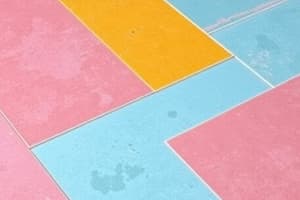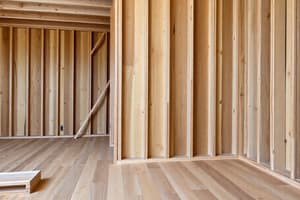Podcast
Questions and Answers
A gradient of 1/30 is required from manger to the rear dung channel in animal house flooring.
A gradient of 1/30 is required from manger to the rear dung channel in animal house flooring.
False (B)
Vitrified paving bricks can be used as a flooring material in animal houses.
Vitrified paving bricks can be used as a flooring material in animal houses.
True (A)
Gravel is not suitable for flooring in animal houses due to its high cost.
Gravel is not suitable for flooring in animal houses due to its high cost.
False (B)
Cement concrete floors are not suitable for tropical conditions.
Cement concrete floors are not suitable for tropical conditions.
Building bricks are considered excellent floor materials for animal houses.
Building bricks are considered excellent floor materials for animal houses.
Gravel flooring is durable and does not require periodical repair and maintenance.
Gravel flooring is durable and does not require periodical repair and maintenance.
Vitrified paving bricks are soft and porous.
Vitrified paving bricks are soft and porous.
A slope of 1/40 to 1/60 is desirable towards the dung channel for deep litter floors.
A slope of 1/40 to 1/60 is desirable towards the dung channel for deep litter floors.
Lime dressing is not necessary for the maintenance of gravel floors.
Lime dressing is not necessary for the maintenance of gravel floors.
Deep litter floors can be used for animals other than sheep and goats.
Deep litter floors can be used for animals other than sheep and goats.
Flashcards are hidden until you start studying
Study Notes
Floor Construction and Design
- A floor is a crucial part of a building, especially in an animal house, as it is frequently used by animals for resting, movement, feeding, and milking.
- A floor should be strong, durable, and non-slippery to ensure animal safety and comfort.
Floor Materials
- Various materials can be used for animal house flooring, including cement concrete, vitrified paving bricks, stones, building bricks, and gravel.
- Cement concrete floors are common, cheap, and durable, but require grooves and rough surfaces to prevent accidents.
- Building bricks are not ideal due to water absorption and wear, but can be used with good quality cement.
- Vitrified paving bricks are durable, damp-proof, and ideal for animal flooring.
- Stones, such as granite, are durable and strong, but require a cushion of sand and roughening of the surface.
- Gravel is a cheap option, but absorbs water, wears out quickly, and requires periodical repair and maintenance.
Floor Design
- Solid floors can be made of various materials, including cement concrete, vitrified paving bricks, building bricks, stones, and gravel.
- Solid floors should be laid properly for good drainage, with a slope of 1/40 to 1/60 towards the dung channel.
- Deep litter floors involve layering bedding materials, such as straw or sawdust, to absorb moisture and control bacterial activity.
- Lime can be added to deep litter floors to control excessive bacterial action.
Studying That Suits You
Use AI to generate personalized quizzes and flashcards to suit your learning preferences.




